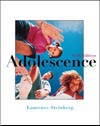Children and adolescents are treated differently in the criminal justice system than adults are. What are some of the differences between the juvenile justice system and the adult criminal system in your state, and where do those differences come from? Under what conditions are youth moved from one system to another? Given what you know about adolescent cognitive and social development, write a set of guidelines that would help law enforcement officials decide which system a particular youth would be referred to.
Adolescents are both the victims and perpetrators of crime. When do we think
of them as children, and when as adults?
 |
1 |  | 
Which of the following statements best explains why autonomy is a particularly important issue during adolescence? |
|  | A) | The development of autonomy ends at the end of adolescence and autonomy issues are not a concern for older adults. |
|  | B) | Young children do not experience autonomy issues, so adolescence is the first time researchers can study autonomy development. |
|  | C) | The physical, cognitive, and social changes that take place during adolescence provide a foundation for the development of autonomy. |
 |
 |
2 |  | 
Mrs. Hunter comes home from a bad day at work and sits down to talk with her 17-year-old daughter, Mary. Mrs. Hunter begins to talk about her rough day and is surprised to find that Mary is interested and sympathetic. This is a sign that Mary has developed what kind of autonomy? |
|  | A) | emotional autonomy |
|  | B) | behavioral autonomy |
|  | C) | value autonomy |
|  | D) | empathic autonomy |
 |
 |
3 |  | 
According to the textbook, what does research show about detachment? |
|  | A) | Detachment is a normal and necessary part of emotional development during adolescence. |
|  | B) | Some adolescents can become autonomous without severing emotional ties with parents, but those who experience detachment will be more mature. |
|  | C) | Detachment is not integral to the development of autonomy. Most families maintain high levels of closeness during adolescence and do not experience detachment. |
 |
 |
4 |  | 
Which combination of parenting practices is best for encouraging individuation? |
|  | A) | Close relationships and constraining behavior |
|  | B) | Close relationships and enabling behavior |
|  | C) | Distant relationships and constraining behavior |
|  | D) | Distant relationships and enabling behavior. |
 |
 |
5 |  | 
Which statement best describes adolescents' decision-making abilities and their rights to make decisions about their own health care? |
|  | A) | Decision-making abilities do not improve during adolescence; therefore, adolescents cannot be trusted to make decisions about their own health care. |
|  | B) | Decision-making abilities improve during adolescence, but policy-makers cannot agree on whether and at what age adolescents should be allowed to make decisions about their own health care. |
|  | C) | Decision making abilities improve during adolescence, and most states give adolescents full-decision making power about their own health care at the age of 15. |
 |
 |
6 |  | 
Which of the following statements about parents' and peers' influence on adolescents is true? |
|  | A) | Parents have the most influence over both short-term and long-term issues. |
|  | B) | Peers have the most influence over both short-term and long-term issues. |
|  | C) | Parents have the most influence over short-term issues, and peers have the most influence over long-term issues. |
|  | D) | Peers have the most influence over short-term issues, and parents have the most influence over long-term issues. |
 |
 |
7 |  | 
Dr. Elwood does a study of the effects of parents' job-related stress on adolescents' closeness with parents. If adolescents are the focus of the study, what level of effect is job-related stress? |
|  | A) | a microsystem effect |
|  | B) | a mesosystem effect |
|  | C) | an exosystem effect |
|  | D) | a macrosystem effect |
 |
 |
8 |  | 
Which of the following factors directly increase the likelihood that an individual will develop postconventional moral reasoning? Check all that apply. |
|  | A) | Number of older siblings |
|  | B) | Authoritative parenting |
|  | C) | Age |
|  | D) | Education |
|  | E) | Socioeconomic status |
|  | F) | Gender |
 |
 |
9 |  | 
What is Gilligan's main criticism of Kohlberg's theory of moral development? |
|  | A) | Kohlberg places too much emphasis on a justice orientation, which is preferred by males. |
|  | B) | Kohlberg places too much emphasis on a care orientation, which is preferred by females. |
|  | C) | Kohlberg places too much emphasis on a justice orientation, which is preferred by females. |
|  | D) | Kohlberg places too much emphasis on a care orientation, which is preferred by males. |
 |
 |
10 |  | 
How does political thinking change during adolescence? |
|  | A) | It becomes less abstract, more authoriarian, and relies less on a set of principles. |
|  | B) | It becomes more abstract, less authoritarian, and relies more on a set of principles. |
|  | C) | It becomes less abstract, less authoritarian, and relies less on a set of principles. |
|  | D) | It becomes more abstract, more authoritarian, and relies more on a set of principles. |
 |



 2002 McGraw-Hill Higher Education
2002 McGraw-Hill Higher Education